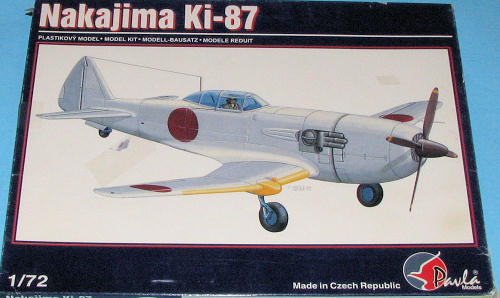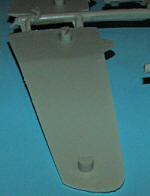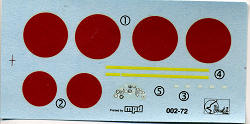
Pavla 1/72 Nakajima Ki-87
| KIT #: | 72002 |
| PRICE: | $18.98 MSRP |
| DECALS: | One option |
| REVIEWER: | Scott Van Aken |
| NOTES: | Includes cast metal, vacuform, and photo etched parts |

| HISTORY |
The Ki-87 was developed in response to American B-29 Superfortress raids on the Home Islands. It followed up on earlier research by Nakajima and the Technical Division of Imperial Army Headquarters into boosting a large radial engine with a turbo-supercharger, which had begun in 1942, well before the B-29 raids began. The turbo-supercharger would allow for good performance at high altitudes.
Construction was delayed due to problems with the turbo-supercharger, and the prototype was not completed until February 1945; it first flew in April, but only five test flights were completed.
| THE KIT |
 This
is Pavla's second kit and shows how far this short run company has come over the
years. There is a single sprue containing the injected plastic parts, a small
bag of metal bits, a photo etch sprue, two vacuformed canopies and (not shown) a
section of screen mesh.
This
is Pavla's second kit and shows how far this short run company has come over the
years. There is a single sprue containing the injected plastic parts, a small
bag of metal bits, a photo etch sprue, two vacuformed canopies and (not shown) a
section of screen mesh.
 The
plastic bits are lightly engraved panel lines with the big pieces having large
ejector towers and some of the smaller bits being almost buried in flash
and plastic blobs. The tail wheel will take some major drilling and shaping to
remove the part from its surrounding plastic. Yes, this is old style short run.
The metal castings are for the turbo, exhaust and engine fan. The first two
items are also done in plastic, but the metal castings are better.
The
plastic bits are lightly engraved panel lines with the big pieces having large
ejector towers and some of the smaller bits being almost buried in flash
and plastic blobs. The tail wheel will take some major drilling and shaping to
remove the part from its surrounding plastic. Yes, this is old style short run.
The metal castings are for the turbo, exhaust and engine fan. The first two
items are also done in plastic, but the metal castings are better.
Photo etch is used for gear doors, wheel well interior and
oleo scissors. The two vacuformed canopies are fairly well done and thick enough
to allow you to cut them without too much trauma. The mesh screen is to be
placed behin d
the turbo assembly. Actually, it looks like one installs the mesh and glues the
metal turbo bits to it.
d
the turbo assembly. Actually, it looks like one installs the mesh and glues the
metal turbo bits to it.
Instructions are well drawn and show any trimming needed as well as when you need to fabricate parts from stretched sprue. As I mentioned in the opening, this is an old style short run kit. The decal sheet is for the lone prototype and looks to be well printed. As this kit has been around for over a decade, one has to wonder how viable the sheet still might be.
| CONCLUSIONS |
So there you have it. A look at something from our collective past. The kit has been on the shelves so long that the MSRP has become reasonable. Not for the faint at heart, but if you really want to build a shelf full of Japanese prototypes, this is your only viable option.
| REFERENCES |
http://en.wikipedia.org/wiki/Nakajima_Ki-87
May 2010 If you would like your product reviewed fairly and quickly, please
contact
me or see other details in the
Note to
Contributors.